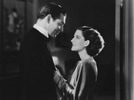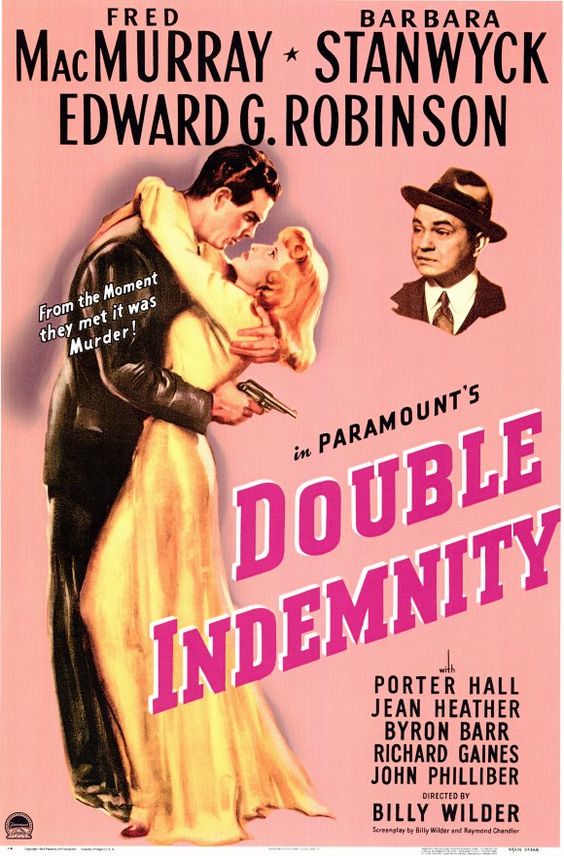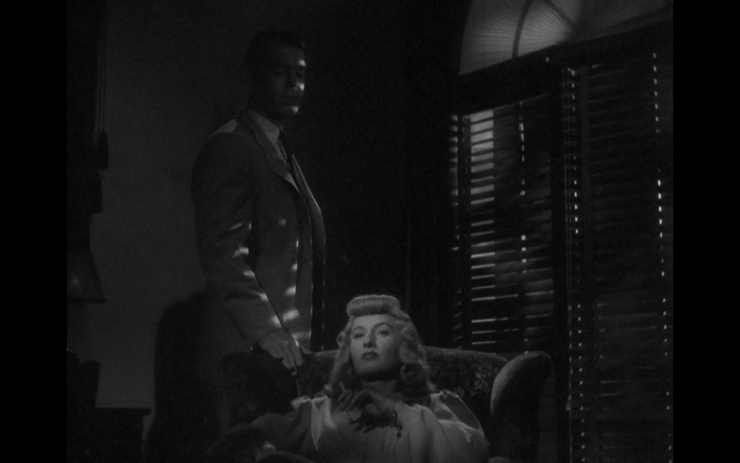Double Indemnity Intro & NotesPreamble: Billy Wilder had made 2 films before he wrote and directed Double Indemnity in 1944. Many people consider it his best film, even in a career that created Sunset Boulevard, Some Like it Hot, The Apartment and several other classics and near classics. Perhaps what makes Double Indemnity just a little different is its place in Film Noir, the easy to spot, but somewhat difficult to describe film movement that peaked in the late 40’s, but continues to fascinate film fans and film makers even today. Ask someone to describe what a Film Noir is and they’ll inevitably refer to something characteristic of Double Indemnity. The quick staccato dialogue, laced with sexual inuendo. The venetian blinds cutting diagonal lines across the screen or the deep shadows that surround pools of light, even in rooms shot during the day. Perhaps it would be the femme fatale leading lady who corrupts and destroys a seemingly innocent dupe. Or murder. Or infidelity. It could be any number of things that makes Double Indemnity the quintessential Film Noir, but for this film that’s literally just the tip of the iceberg.
Double Indemnity not only represents Film Noir, but can also be looked at as the coalescence of pretty much everything that was going on in Hollywood at the time of its creation. First and foremost, was the struggle between the Hollywood studios and the Production Code office that enforced strict censorship rules. Any film about adultery and murder was certainly on the censors hit list. There was also the increasing power of independent minded directors, like Wilder, who were looking to buck the studio system’s control over their work. Within a decade that system would be crumbling, in part because of the pressure from people like Wilder. There was also the emerging influence of Eastern European refugees who had been coming to Hollywood in droves since the early 30’s & were wielding their immense creative powers at every level of production. Finally, there was the neophyte screenwriter, an accomplished novelist in his own right, asked to rewrite a novelist he didn’t care for, all the while collaborating with a director with very particular habits while writing. It was almost enough to drive him to drink, but it all came together to create one of the greatest films ever made. For me, Double Indemnity ticks every box on the classic film scorecard. The script is air tight, with not a single wasted word. The images on the screen capture mood, emotion, and story in a complex, but unobtrusive manner. The music subtlety reminds you you’re watching a movie without ever taking you out of the story, while the casting and performances draw you deeper into the tangled web of seduction, deciept and betrayal. A simple story of a man lured out of the sunshine and into the shadows. Double indemnity is perfection personified and every viewing offers many different avenues for discussion, but even seen for the first time it is apparent that its influence is still hard at work some 80 years after its release. For a movie made in 1944, Murder had never looked so sexy. Starring Barbara Stanwyck, Fred Mac Murray and Edward G. Robinson, with a cameo by Raymond Chandler, I hope you enjoy Double Indemnity as much as I do. I look forward to our discussion after the screening. |
Double Indemnity Note
i.1930’s Hardboiled (Hammett, Cain, Chandler, Horace McCoy)
1.Depression Era
ii.Pulp magazines: Black Mask, Front Page Detective, Crime Cases,
iii.Hemmingway indebted (fatalism/sparse prose)
iv.German Emigrants
1.Wilder, Fritz Lang, Otto Preminger, Robert Siodmak
b.Style
i.Light vs Dark (on screen & on page)
ii.German Expressionism
iii.Lighting (chiaroscuro)
iv.Non-linear storytelling/voice over narration/flashbacks
v.Setting (urban/gritty)
1.Big City (New York skyscrapers)
2.Los Angeles (sunshine vs. darkness)
vi.Tone (ordinary people caught in extraordinary circumstances)
1.Oppressive (sets & locations)
2.Foreboding
vii.Color Noirs: Leave Her to Heaven, Niagara
c.Post-War Attitude
i.Promoted as “Crime Thrillers” or “Murder Mysteries”
ii.Femme Fatale represented post-war inadequacies of men (working woman)
d.French Critics
i.1946 Frech Film Journal
ii.Raymond Borde & Etienne Chaumeton. A Panaramoa of American Film Noir (1955)
e.Film Movement
i.1941: The Maltese Falcon (John Huston)
ii.1958: Touch of Evil (Orson Welles)
iii.A-Level: Laura, Asphalt Jungle,
i.Managing Editor of The New Yorker
ii.Wrote collection of ficticious dialogues Our Government (Knopf)
iii.1931 came to Hollywood (Paramount)
b.Backstory
i.1927 Sydney-Gray case
c.The Postman Always Rings Twice
d.Hollywood Adaptions
e.Response to Double Indemnity’s release
b.Written on deadline for serialization in Liberty Magazine for quick cash.
c.Changes in Film
i.Names: Nerdlinger & Huff
ii.Phyllis’ entrance. Described as washed out Blue pajamas, loose, but moments later Walter note killer body.
iii.Phyliss a serial killer (3 kids, Neff’s first wife, etc.)
iv.Walter knows she mentions accident insurance she wants him dead (p11)
v.FAVORITE LINE: “That’s all it takes, one drop of fear to curdle love into hate”
vi.Walter/Lola: He loves her. Sexual relationship?
vii.FINAL SCENE: Walter waits in car to kill Phyllis by pushing boyfriends car off cliff. She shoots him & Lola/Sahcetti come upon scene. Walter ends up at hospital
i.Vianese born
ii.Berlin writer, tour guide, taxi dancer
d.Writing Partners:
i.Charles Brackett: 14 years
ii.IAL Diamond
e.Screenwriter
i.Andrew Sarris: “Wilder was too clever & cynical for his own and everyone else’s good. The flamboyant glibness of his characters was proof of his insecurity.”
ii.Ninotchka (’39), Bluebeard’s Eighth’s Wife-Lubitsch
1.“What Would Lubitsch Do”
iii.Ball of Fire (Stanwyck) ‘41
f.Writer/Director
i.The Major & the Minor (Rogers/Miland) Rogers playing 16 yo in pig tails
ii.Five Graves to Cairo ’42 Von Stroheim as Rammel
iii.Lost Weekend (’45)-Best Picture, Director & Screenplay (actor)
iv.Foreign Affair, Sunset Blvd, Ace in the Hole, Stalig 17, Sabrina, 7 Year Itch, Spirit of St Louis, Love in the Afternoon, Witness for the Prosecution, Some Like it Hot, The Apartment
b.Showgirl
c.Early Career
i.Frank Capra
d.1930’s
e.Great Performances
f.Double Indemnity: “performance a triumph in restraint”
i.“I’m afraid to go home with her. She’s such a bitch.”-Stanwyck on Phyllis
b.Art collector, gentleman. Suffered during communist witch hunt. Gray listed?
c.First film in 14 years where he wasn’t the headliner
d.Almost passed on role due to supporting nature. Reconsidered as bridge to character roles for remainder of career
e.Later starred in Fritz Lang’s Noir classics: Woman in the Window & Scarlett St
b.All bids were withdrawn
e.Approved in partial form
i.Careful with “disposition of the body”
ii.Gas chamber scene for closure, but tasteful
iii.Primary concern was skimpiness of towel
f.To his death Cain claimed Breen owed him $10,000 for knocking down purchase price
i.Double Indemnity follow up to POSTMAN ALWAYS RINGS TWICE
ii.Hot property ($50,000 expected). Multiple Studios. Production Code office said a film couldn’t be made, so price dropped
iii.Chandler’s tale about Wilder’s secretary reading in bathroom
iv.Producer (uncredited) Joe Systrom brought it Wilder
v.Cain approached, but tied up at another studio
ii.Early Career-Oil company, fired alcoholism
iii.Married to woman 17 years his senior (in 70’s when DI written)
iv.Style
1.Dialogue & description
v.Novels
1.Murder, My Sweet (Marlowe)
2.Farewell, My Lovely
3.The Big Sleep-“Who killed the chauffer?”-Marlowe
4.Lady in the Lake-Marlowe
5.The Long Goodbye (Marlowe)
vi.Working With Wilder
1.Wrote initial 88-page script that Wilder called “shit” in 4 days.
a.Agreed to write for $1,000
b.Paramount gave him $750 wk for 12 weeks
2.Wilder’s first script w/o Charles Brackett (Ninotchka) in 14 yrs.
3.Wilder: “a kind of lightning struck on every page.”
4.Memo of complaints
a.Riding crop, frequent lady calls, drinking at lunch, walked around too much
5.“Working with Wilder probably shortened my life”
vii.Hollywood Career
1.Blue Dahlia: wrote at home drunk (contract stipulation)
2.Strangers on a Train (first crack/most removed)
c.Alternate Ending
i.Gas Chamber scene
i.Narrated by Protagonist-HIS STORY
b.Determinism (flashback)
i.Walter’s desire to “Crook the House”
ii.Repeated implications of machine -like web pushing Neff forward w/o control
c.Tabloid in nature (headline tells outcome-how & why more important than outcome
d.Black Widow (sex=death)
e.Suspense: Car not starting
i.Wilder had issue leaving for lunch. Went back in & shot new scene.
b.Chandler dialogue expert
c.Quatable Lines:
i.“Mr Jackson, we’re not in Medford, we’re in a hurry”-Keyes to witness
ii.“Ostiopath? Just don’t put her on the expense report!”-Keyes to witness
iii.Recitation of Suicide actuarial table.
i.Cinematographer: John F. Seitz (Sunset Blvd, Lost Weekend, Sullivan’s Travels
1.Seven Oscar Noms: Five Graves to Cairo (3 w/Wilder)
ii.Composer: Miklos Rozsa (Ben hur, Spellbound, Lost Weekend, The Killers)
1.3 Oscar wins/17 noms: A Double Life (47), Ben Hur (’60), Spellbound (’46)
i.Reviews offered confusion (how to pinpoint film-highbrow or trash)
ii.Some just offended
iii.Some tried to link it to classic lit (James Agee)/Others Foreign films (French Realism-Crowther)
b.Box Office
c.Awards/Oscar Nominations
i.Seven Oscar Noms: Picture, Actress, Director, Screenplay, Cinematography, Sound, Music
b.Body Heat (1981): Kathleen Turner, William Hurt, Richard Crenna, Mickey Rourke, Ted Danson
- Film Noir
i.1930’s Hardboiled (Hammett, Cain, Chandler, Horace McCoy)
1.Depression Era
ii.Pulp magazines: Black Mask, Front Page Detective, Crime Cases,
iii.Hemmingway indebted (fatalism/sparse prose)
iv.German Emigrants
1.Wilder, Fritz Lang, Otto Preminger, Robert Siodmak
b.Style
i.Light vs Dark (on screen & on page)
ii.German Expressionism
iii.Lighting (chiaroscuro)
iv.Non-linear storytelling/voice over narration/flashbacks
v.Setting (urban/gritty)
1.Big City (New York skyscrapers)
2.Los Angeles (sunshine vs. darkness)
vi.Tone (ordinary people caught in extraordinary circumstances)
1.Oppressive (sets & locations)
2.Foreboding
vii.Color Noirs: Leave Her to Heaven, Niagara
c.Post-War Attitude
i.Promoted as “Crime Thrillers” or “Murder Mysteries”
ii.Femme Fatale represented post-war inadequacies of men (working woman)
d.French Critics
i.1946 Frech Film Journal
ii.Raymond Borde & Etienne Chaumeton. A Panaramoa of American Film Noir (1955)
e.Film Movement
i.1941: The Maltese Falcon (John Huston)
ii.1958: Touch of Evil (Orson Welles)
iii.A-Level: Laura, Asphalt Jungle,
- James M. Cain
i.Managing Editor of The New Yorker
ii.Wrote collection of ficticious dialogues Our Government (Knopf)
iii.1931 came to Hollywood (Paramount)
b.Backstory
i.1927 Sydney-Gray case
c.The Postman Always Rings Twice
d.Hollywood Adaptions
e.Response to Double Indemnity’s release
- Double Indemnity Novella
b.Written on deadline for serialization in Liberty Magazine for quick cash.
c.Changes in Film
i.Names: Nerdlinger & Huff
ii.Phyllis’ entrance. Described as washed out Blue pajamas, loose, but moments later Walter note killer body.
iii.Phyliss a serial killer (3 kids, Neff’s first wife, etc.)
iv.Walter knows she mentions accident insurance she wants him dead (p11)
v.FAVORITE LINE: “That’s all it takes, one drop of fear to curdle love into hate”
vi.Walter/Lola: He loves her. Sexual relationship?
vii.FINAL SCENE: Walter waits in car to kill Phyllis by pushing boyfriends car off cliff. She shoots him & Lola/Sahcetti come upon scene. Walter ends up at hospital
- Billy Wilder
- Oscar Wins: 6
- Apartment: Picture, Director, Screenplay
- Lost Weekend: Picture, Director, Screenplay
- Oscar Noms: 21 nominations
- 9 Best Director
- 12 Best Screenplay
- Oscar Wins: 6
i.Vianese born
ii.Berlin writer, tour guide, taxi dancer
d.Writing Partners:
i.Charles Brackett: 14 years
ii.IAL Diamond
e.Screenwriter
i.Andrew Sarris: “Wilder was too clever & cynical for his own and everyone else’s good. The flamboyant glibness of his characters was proof of his insecurity.”
ii.Ninotchka (’39), Bluebeard’s Eighth’s Wife-Lubitsch
1.“What Would Lubitsch Do”
iii.Ball of Fire (Stanwyck) ‘41
f.Writer/Director
i.The Major & the Minor (Rogers/Miland) Rogers playing 16 yo in pig tails
ii.Five Graves to Cairo ’42 Von Stroheim as Rammel
iii.Lost Weekend (’45)-Best Picture, Director & Screenplay (actor)
iv.Foreign Affair, Sunset Blvd, Ace in the Hole, Stalig 17, Sabrina, 7 Year Itch, Spirit of St Louis, Love in the Afternoon, Witness for the Prosecution, Some Like it Hot, The Apartment
- Barbara Stanwyck
b.Showgirl
c.Early Career
i.Frank Capra
d.1930’s
e.Great Performances
f.Double Indemnity: “performance a triumph in restraint”
i.“I’m afraid to go home with her. She’s such a bitch.”-Stanwyck on Phyllis
- Edward G. Robinson
b.Art collector, gentleman. Suffered during communist witch hunt. Gray listed?
c.First film in 14 years where he wasn’t the headliner
d.Almost passed on role due to supporting nature. Reconsidered as bridge to character roles for remainder of career
e.Later starred in Fritz Lang’s Noir classics: Woman in the Window & Scarlett St
- Fred Mac Murray
- Production Code
b.All bids were withdrawn
- Joe Breen: “Low tone and sordid flavor of this story makes it, in our judgement, thoroughly unacceptable for screen presentation before mixed audiences.”
e.Approved in partial form
i.Careful with “disposition of the body”
ii.Gas chamber scene for closure, but tasteful
iii.Primary concern was skimpiness of towel
f.To his death Cain claimed Breen owed him $10,000 for knocking down purchase price
- Screenplay
i.Double Indemnity follow up to POSTMAN ALWAYS RINGS TWICE
ii.Hot property ($50,000 expected). Multiple Studios. Production Code office said a film couldn’t be made, so price dropped
iii.Chandler’s tale about Wilder’s secretary reading in bathroom
iv.Producer (uncredited) Joe Systrom brought it Wilder
v.Cain approached, but tied up at another studio
- Raymond Chandler
ii.Early Career-Oil company, fired alcoholism
iii.Married to woman 17 years his senior (in 70’s when DI written)
iv.Style
1.Dialogue & description
v.Novels
1.Murder, My Sweet (Marlowe)
2.Farewell, My Lovely
3.The Big Sleep-“Who killed the chauffer?”-Marlowe
4.Lady in the Lake-Marlowe
5.The Long Goodbye (Marlowe)
vi.Working With Wilder
1.Wrote initial 88-page script that Wilder called “shit” in 4 days.
a.Agreed to write for $1,000
b.Paramount gave him $750 wk for 12 weeks
2.Wilder’s first script w/o Charles Brackett (Ninotchka) in 14 yrs.
3.Wilder: “a kind of lightning struck on every page.”
4.Memo of complaints
a.Riding crop, frequent lady calls, drinking at lunch, walked around too much
5.“Working with Wilder probably shortened my life”
vii.Hollywood Career
1.Blue Dahlia: wrote at home drunk (contract stipulation)
2.Strangers on a Train (first crack/most removed)
c.Alternate Ending
i.Gas Chamber scene
- Plot Structure
i.Narrated by Protagonist-HIS STORY
b.Determinism (flashback)
i.Walter’s desire to “Crook the House”
ii.Repeated implications of machine -like web pushing Neff forward w/o control
c.Tabloid in nature (headline tells outcome-how & why more important than outcome
d.Black Widow (sex=death)
e.Suspense: Car not starting
i.Wilder had issue leaving for lunch. Went back in & shot new scene.
- Script Writing
b.Chandler dialogue expert
c.Quatable Lines:
i.“Mr Jackson, we’re not in Medford, we’re in a hurry”-Keyes to witness
ii.“Ostiopath? Just don’t put her on the expense report!”-Keyes to witness
iii.Recitation of Suicide actuarial table.
- Pre-Production
- Production
i.Cinematographer: John F. Seitz (Sunset Blvd, Lost Weekend, Sullivan’s Travels
1.Seven Oscar Noms: Five Graves to Cairo (3 w/Wilder)
ii.Composer: Miklos Rozsa (Ben hur, Spellbound, Lost Weekend, The Killers)
1.3 Oscar wins/17 noms: A Double Life (47), Ben Hur (’60), Spellbound (’46)
- Reception
i.Reviews offered confusion (how to pinpoint film-highbrow or trash)
ii.Some just offended
iii.Some tried to link it to classic lit (James Agee)/Others Foreign films (French Realism-Crowther)
b.Box Office
c.Awards/Oscar Nominations
i.Seven Oscar Noms: Picture, Actress, Director, Screenplay, Cinematography, Sound, Music
- Legacy
b.Body Heat (1981): Kathleen Turner, William Hurt, Richard Crenna, Mickey Rourke, Ted Danson


